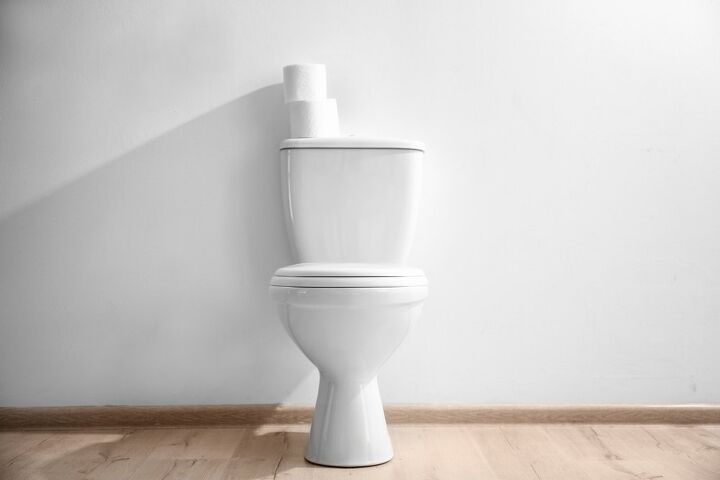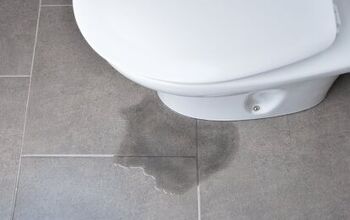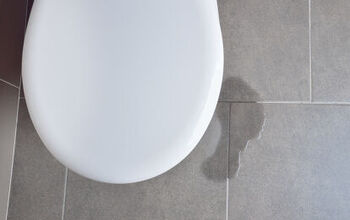Is Your Toilet Coupling Nut Leaking? (Fix It Now!)

If your toilet is leaking, it can quickly create a disaster in a bathroom. Not only can a leaky toilet create a problematic situation in your bathroom, leading to mold and mildew, but it can be costly to waste water, which can cause sky-high utility bills. Luckily, most toilet leaks are easy to identify and simple to repair, requiring just a few standard tools that most DIY homeowners have.
A leaking toilet at the base of the water tank is usually the result of a bad toilet coupling nut. The toilet coupling nut is a connector that helps to connect the main water supply to the fill valve within the toilet. Usually, a leaking toilet coupling nut simply requires a new rubber washer installation to help eliminate the leak between the outside and inside of the water tank.
If the toilet is leaking from inside the tank, chances are the fill valve located within the tank has a faulty washer. The replacement process is just as easy as changing the washer on a coupling nut. Many homeowners can repair their leaking toilet in as little as thirty minutes, offering a fast, effective, and easy solution. Fixing a leaking toilet can help keep your bathroom clean and safe and save money on expensive utility costs.
Do You Need to Install or Repair a Toilet?
Get free, zero-commitment quotes from pro contractors near you.

What is a Toilet Coupling Nut?
A toilet coupling nut is a component on a standard toilet that helps to make a secure connection between the main water supply line and the valve within the toilet tank that fills the tank. This watertight seal is made between the outside waterline and the inside of the toilet. Within the toilet coupling nut is usually a rubber or synthetic washer, which is clamped down once tightened, helping to create a watertight seal.
The toilet coupling nut is located on the outside of the toilet. It is usually located near the base of the toilet tank and frequently will be on the left side of the tank. The nut is the area where the main supply line enters into the toilet tank. If you are having trouble locating the coupling nut, trace the water supply line from the wall where it enters the bathroom to the toilet tank. The water supply line will have a hexagonal bolt attaching it to the tank.
What Are the Signs of a Leaking Toilet Coupling Nut?
Some condensation on the outside of a toilet tank is normal as the water in the tank is usually a different temperature from the outside air. However, if you notice more water than usual collecting on the water supply line going into your toilet, you may have a leak in the coupling nut. Dripping water or pooling water are sure signs of a leaking toilet.
To test for certain leaks, wipe any residual moisture away from the supply line and the toilet tank. Flush the toilet and carefully monitor the point where the supply line enters into the toilet tank. You may want to use a dry paper towel and wipe around the area to see if any water droplets have leaked out of the coupling nut.
Why is My Toilet Coupling Nut Leaking?
While toilets are incredibly long-lived, they have several internal components that must be replaced as a part of routine maintenance. A leaking coupling nut is a very common problem and is prevalent with older toilets that use natural washers compared to modern-day synthetic washers. Over time, the natural rubber washer will break down in older toilets, causing leaks to form.
Usually, if you find the coupling nut leaking, the rubber washer is to blame, which connects to the main supply line, leading to the fill valve. A functioning washer would typically make a tight seal between the tank and the supply line, but tiny tears and cracks cause the seal to leak.
What Tools Do I Need to Fix a Coupling Nut?
Fixing a coupling nut on a leaky toilet is a very easy and straightforward repair. You will only need simple, basic tools to complete this fix. To fix a coupling nut, you will need:
- Wrench (multiple sizes or an adjustable wrench is best)
- New Water Supply Line
- Synthetic Washer Replacements
- Teflon Tape
How Can I Fix a Leaking Coupling Nut?
A leaking coupling nut is a very easy fix that most homeowners will be able to do themselves. With the right tools, a coupling nut can be replaced in a matter of minutes. To fix a leaking coupling nut, you must:
Step 1: Shut Off Water
You will want to shut off the main water supply to the bathroom and drain the water from the toilet tank.
Step 2: Unscrew Water Line
Start by locating the water supply line on the outside of the toilet. Unscrew this supply line, and remove and inspect the internal washer. The washer should be in one piece, have a regular shape, and be firm and flexible. If the washer is not, this is the culprit for the leak, and it must be replaced.
Step 3: Replace Water Line and Washer
Using your new water line and included washer, replace the old water line. To make an extra tight seal, you will want to use some plumber’s tape or Teflon tape around the threads that the nut will screw into. Always be sure to wrap the tape in the direction the screw will turn.
Step 4: Test
Reassemble the waterline and do a quick test to check for leaks. If there is still a leak present, double-check to ensure you have replaced the washer with the nut and new supply line. Sometimes the washer can inadvertently fall off while going through the replacement process.
Step 5: Turn on Water
Once you have confirmed the new connection is leak-free, you can turn the water supply back on to the bathroom. Your toilet should be leak-free again.
What If My Leak Comes from Inside the Tank?
While it is common to see the outside of the coupling nut leaking, sometimes the leak comes from inside the tank. If this happens, usually, the issue is with the fill valve and its connections. Luckily, the fix for a leak inside the tank is just as simple to fix.
Step 1: Disassemble
To fix a leak coming from inside the toilet tank, you will want to disassemble the tank as detailed above.
Step 2: Remove Fill Valve
Loosen the retaining nut that is on the outside bottom of the tank, where the supply line enters the toilet. Once this nut is loosened, you will be able to remove the fill valve.
Step 3: Inspection and Replacement
Inspect and replace the washer around the valve. Look for any cracks in the body of the valve that may be causing a leak. Once replaced, simply reinstall and tighten the nuts and bolts.
Is It Possible to Overtighten a Fitting?
While it may be tempting to tighten a fitting, like a toilet coupling nut, as tight as possible, resist the urge. Tightening your fittings too securely can actually do more harm than good. It is possible to crack or tear the thin plastic, and rubber washers found within the fitting and nut itself with too much pressure. If the washer is compromised, even a brand-new coupling nut and fitting can leak.
Can the Water Supply Line Leak?
While the water supply line helps to connect freshwater to the toilet tank at the toilet itself, remember that the water supply line is also connected to the wall. When you replace the water supply line, you will often have to disconnect the supply line from both the toilet tank and the wall.
Follow the same procedures for tightening the water supply line at the wall for the tank connection. Before declaring your leaky toilet fixed, make sure you check the wall connection for possible leaks as well. Using plumber’s tape at both the tank connection and wall connection can help reduce the chance of a leaky fitting.
Do You Need to Install or Repair a Toilet?
Get free, zero-commitment quotes from pro contractors near you.

Related Questions
What happens if my toilet is leaking from the bottom base?
Fixing a leak at the coupling nut is a rather straightforward fix but only helps for leaks located near the toilet tank. Sometimes, leaks occur at the base of the toilet, which will require a different fix. If you notice water pooling or standing around the toilet base, you might have a leak within the wax seal that adheres the toilet to the floor. Luckily, replacing a wax seal and the attached bolts is an easy DIY fix that most homeowners can do themselves in just a few hours.
How long will a toilet last?
A conventional toilet in a home can last up to 50 years under the right conditions. While this seems like a long time compared to other appliances and fixtures, keep in mind that some routine maintenance on wear and tear items, like gaskets and washers, may be required to keep your toilet in good condition.
Related Articles

We are a team of passionate homeowners, home improvement pros, and DIY enthusiasts who enjoy sharing home improvement, housekeeping, decorating, and more with other homeowners! Whether you're looking for a step-by-step guide on fixing an appliance or the cost of installing a fence, we've here to help.
More by Upgraded Home Team



























